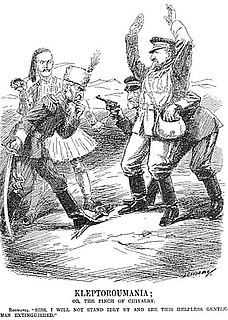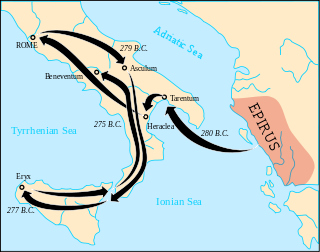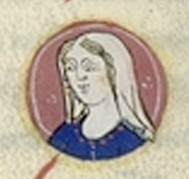The Comoedia Lydiae (or Lidia) is a medieval Latin elegiac comedy from the late twelfth century. The "argument" at the beginning of the play refers to it as the Lidiades (line 3, a play on Heroides ), which the manuscripts gloss as comedia de Lidia facta (a comedy made about Lidia) and which its English translator gives as Adventures of Lidia. [1]

Medieval Latin was the form of Latin used in Roman Catholic Western Europe during the Middle Ages. In this region it served as the primary written language, though local languages were also written to varying degrees. Latin functioned as the main medium of scholarly exchange, as the liturgical language of the Church, and as the working language of science, literature, law, and administration.
Elegiac comedy was a genre of medieval Latin literature—or drama—which survives as a collection of about twenty texts written in the 12th and 13th centuries in the liberal arts schools of west central France. Though commonly identified in manuscripts as comoedia, modern scholars often reject their status as comedy. Unlike Classical comedy, they were written in elegiac couplets. Denying their true comedic nature, Edmond Faral called them Latin fabliaux, after the later Old French fabliaux, and Ian Thomson labelled them Latin comic tales. Other scholars have invented terms like verse tales, rhymed monologues, epic comedies, and Horatian comedies to describe them. The Latin "comedies", the dramatic nature of which varies greatly, may have been the direct ancestors of the fabliaux but more likely merely share similarities. Other interpretations have concluded that they are primitive romances, student juvenilia, didactic poems, or merely collections of elegies on related themes.

The Heroides, or Epistulae Heroidum, is a collection of fifteen epistolary poems composed by Ovid in Latin elegiac couplets and presented as though written by a selection of aggrieved heroines of Greek and Roman mythology in address to their heroic lovers who have in some way mistreated, neglected, or abandoned them. A further set of six poems, widely known as the Double Heroides and numbered 16 to 21 in modern scholarly editions, follows these individual letters and presents three separate exchanges of paired epistles: one each from a heroic lover to his absent beloved and from the heroine in return.
Contents
Lidia was long ascribed to Matthieu de Vendôme, but in 1924 Edmond Faral, in his study of Latin " fabliaux ", discounted this hypothesis. More recently, scholars have argued in favour of the authorship of the cleric Arnulf of Orléans, which now seems secure. [2] The play was probably composed sometime shortly after 1175.
Matthew of Vendôme was a French author of the 12th century, writing in Latin, who had been was a pupil of Bernard Silvestris, at Tours, as he himself writes.
Edmond Faral was an Algerian-born French medievalist. He became in 1924 Professor of Latin literature at the Collège de France.
A fabliau is a comic, often anonymous tale written by jongleurs in northeast France between ca. 1150 and 1400. They are generally characterized by sexual and scatological obscenity, and by a set of contrary attitudes—contrary to the church and to the nobility. Several of them were reworked by Giovanni Boccaccio for the Decameron and by Geoffrey Chaucer for his Canterbury Tales. Some 150 French fabliaux are extant, the number depending on how narrowly fabliau is defined. According to R. Howard Bloch, fabliaux are the first expression of literary realism in Europe.
Compared with the other elegiac comedies, Lidia is not as dependent on Ovid. It is dark and cynical in its view of human nature, even misogynistic. Lidia, the title character, is portrayed as a complete brute, sexually mischievous, faithless, cruel, and completely self-centred. Arnulf is explicit when he claims that Lidia is just a typical woman (line 37).

Publius Ovidius Naso, known as Ovid in the English-speaking world, was a Roman poet who lived during the reign of Augustus. He was a contemporary of the older Virgil and Horace, with whom he is often ranked as one of the three canonical poets of Latin literature. The Imperial scholar Quintilian considered him the last of the Latin love elegists. He enjoyed enormous popularity, but, in one of the mysteries of literary history, was sent by Augustus into exile in a remote province on the Black Sea, where he remained until his death. Ovid himself attributes his exile to carmen et error, "a poem and a mistake", but his discretion in discussing the causes has resulted in much speculation among scholars.
Human nature is a bundle of characteristics, including ways of thinking, feeling, and acting, which humans are said to have naturally. The term is often regarded as capturing what it is to be human, or the essence of humanity. The term is controversial because it is disputed whether or not such an essence exists. Arguments about human nature have been a mainstay of philosophy for centuries and the concept continues to provoke lively philosophical debate. The concept also continues to play a role in science, with neuroscientists, psychologists and social scientists sometimes claiming that their results have yielded insight into human nature. Human nature is traditionally contrasted with characteristics that vary among humans, such as characteristics associated with specific cultures. Debates about human nature are related to, although not the same as, debates about the comparative importance of genes and environment in development.
In style, Lidia is highly rhetorical. Bruno Roy called it "the apotheosis of the pun". [3] Lidia's name is often punned with ludus (game) and ludere (play), often with connotations of deception or sexual activity. Women are the virus that destroys virum (man, virility). Lidia would be unsatisfied even with ten (decem) men, a pun on her husband's name, Decius. The puns, though fashionable in the late twelfth century, make elegance in translation very difficult. [4]

Rhetoric is the art of persuasion. Along with grammar and logic, it is one of the three ancient arts of discourse. Rhetoric aims to study the capacities of writers or speakers needed to inform, persuade, or motivate particular audiences in specific situations. Aristotle defines rhetoric as "the faculty of observing in any given case the available means of persuasion" and since mastery of the art was necessary for victory in a case at law or for passage of proposals in the assembly or for fame as a speaker in civic ceremonies, calls it "a combination of the science of logic and of the ethical branch of politics". Rhetoric typically provides heuristics for understanding, discovering, and developing arguments for particular situations, such as Aristotle's three persuasive audience appeals: logos, pathos, and ethos. The five canons of rhetoric or phases of developing a persuasive speech were first codified in classical Rome: invention, arrangement, style, memory, and delivery.

Apotheosis is the glorification of a subject to divine level. The term has meanings in theology, where it refers to a belief, and in art, where it refers to a genre.

The pun, also called paronomasia, is a form of word play that exploits multiple meanings of a term, or of similar-sounding words, for an intended humorous or rhetorical effect. These ambiguities can arise from the intentional use of homophonic, homographic, metonymic, or figurative language. A pun differs from a malapropism in that a malapropism is an incorrect variation on a correct expression, while a pun involves expressions with multiple interpretations. Puns may be regarded as in-jokes and/or idiomatic constructions, especially as their usage and meaning are usually specific to a particular language and/or its culture.
Lidia is preserved in two fourteenth-century manuscripts. One of them may have been copied by the hand of Giovanni Boccaccio. Regardless, he certainly borrowed the tale for his Decameron , 7.9. His major alteration was the name of Lidia's husband, changed from Decius to Nicostrato. Geoffrey Chaucer also borrowed aspects of Lidia for "The Merchant's Tale", one of The Canterbury Tales .

Giovanni Boccaccio was an Italian writer, poet, correspondent of Petrarch, and an important Renaissance humanist. Boccaccio wrote a number of notable works, including The Decameron and On Famous Women. He wrote his imaginative literature mostly in the Italian vernacular, as well as other works in Latin, and is particularly noted for his realistic dialogue which differed from that of his contemporaries, medieval writers who usually followed formulaic models for character and plot.

Geoffrey Chaucer was an English poet and author. Widely considered the greatest English poet of the Middle Ages, he is best known for The Canterbury Tales. Chaucer has been styled the "Father of English literature" and was the first writer buried in Poets' Corner of Westminster Abbey.

The Canterbury Tales is a collection of 24 stories that runs to over 17,000 lines written in Middle English by Geoffrey Chaucer between 1387 and 1400. In 1386, Chaucer became Controller of Customs and Justice of Peace and, in 1389, Clerk of the King's work. It was during these years that Chaucer began working on his most famous text, The Canterbury Tales. The tales are presented as part of a story-telling contest by a group of pilgrims as they travel together from London to Canterbury to visit the shrine of Saint Thomas Becket at Canterbury Cathedral. The prize for this contest is a free meal at the Tabard Inn at Southwark on their return.







